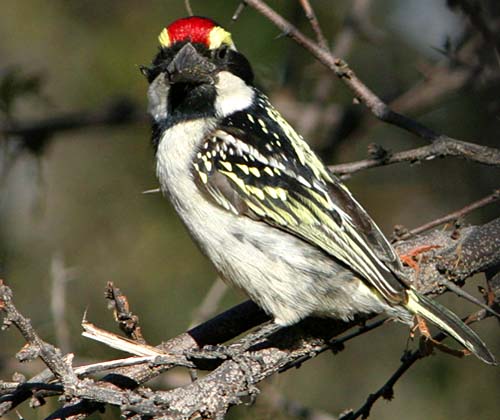Daily Journal
 Day
24 (23 July): Our accommodations near Rundu at the entrance
to the Caprivi Strip was Nkwazi Camp, a small establishment right on the
banks of the Kavango River (which is called the Okavango River in Botswana).
We looked directly across into Angola. War-torn Angola is now open for
visitors again, but we ran into several folks who had been there recently
(including one who did U.N. refugee work), and learned the country is dysfunctional;
bribery is rampant and required to accomplish anything; and that land mines
present a major problem. Nonetheless it was interesting to look across
and, as it turned out, we saw one lifer — Coppery-tailed Coucal — in Angola
before it was seen elsewhere. I actually have an 'Angola list' for about
a dozen species, without ever stepping foot inside the country. There were
a few new birds around camp (Swamp Boubou, Hartlaub's Babbler)
but mostly there were German tourists camping. It is very popular for campers
and backpackers to go on bus tours of this part of Africa. This is a cheap
way to see Africa, and dozens had arrived the night before to put up little
pup tents everywhere throughout the bit of woods around the resort. Day
24 (23 July): Our accommodations near Rundu at the entrance
to the Caprivi Strip was Nkwazi Camp, a small establishment right on the
banks of the Kavango River (which is called the Okavango River in Botswana).
We looked directly across into Angola. War-torn Angola is now open for
visitors again, but we ran into several folks who had been there recently
(including one who did U.N. refugee work), and learned the country is dysfunctional;
bribery is rampant and required to accomplish anything; and that land mines
present a major problem. Nonetheless it was interesting to look across
and, as it turned out, we saw one lifer — Coppery-tailed Coucal — in Angola
before it was seen elsewhere. I actually have an 'Angola list' for about
a dozen species, without ever stepping foot inside the country. There were
a few new birds around camp (Swamp Boubou, Hartlaub's Babbler)
but mostly there were German tourists camping. It is very popular for campers
and backpackers to go on bus tours of this part of Africa. This is a cheap
way to see Africa, and dozens had arrived the night before to put up little
pup tents everywhere throughout the bit of woods around the resort.
While driving out the sandy roads from Nkwazi we came
upon a small rain puddle that held a juvenal Painted Snipe! We stopped
in bits of Brachystegia woods and roadside scrub during our drive through
the Caprivi Strip, netting new trip birds such as Meve's Long-tailed Starling
and Cut-throat Finch. Violet-backed Starling in pairs was a surprise
in mid-winter. A mid-day stop at Mahunga Reserve — the last spot in Namibia
before one crosses the Botswana border — was very productive. This is one
of very few reserves that permits one to leave your car, so we were very
aware that a Lion or Elephant could be around the next bush. The best spot
was at the Giant Baobab (right) which edges a huge swampy plain
that is full of wildlife (Red Lechwe especially) and waterfowl (flocks
of White-faced Whistling-Duck and Spur-winged Geese, herons, jaçanas).
Here we found our only pair of Wattled Crane of the trip. And the
drive through the reserve was entertaining with herds of Sable Antelope
and a pair of Roan Antelope.
After the brief formalities at the border, we drove into
Botswana and almost immediately had a mysterious falcon perched next to
the road. We stopped for a look, it soared up and over our heads and off,
and proved to be a vagrant Gray Kestrel (see annotated
list for details). Past the ramshackle town of Shakawe we found the
signs to Drotsky's Cabins. We were booked here on the banks of the Okavango
River for two nights, but learned that another busload of campers had also
just arrived. We were offered the option of staying at Xaro Camp, about
5 miles downriver, where only 4 American birders were in residence, and
spot reachable only by boat. We jumped at that option. I knew (from Jeri
Langham) that our friends Ed Harper & Susan Scott were somewhere in
southern Africa, so on the long-shot asked if the Americans included an
"Ed and Sue"? "Yes," we were advised. And as our boat pulled into Xaro
Camp late that afternoon, there were Ed & Susan (with their newly wed
friends Michael & Deborah), sitting on the banks of the Okavango, beneath
the tall trees, enjoying an alcoholic beverage. I took this shot (below)
from the boat as we pulled up. Susan & Ed (to the left) still haven't
figured out who we are (they had no idea we were in Africa) while Michael
(who had never met us) waves a friendly hand. Ed and Sue were completely
surprised by our arrival (a more proper group photo is further down this
page):
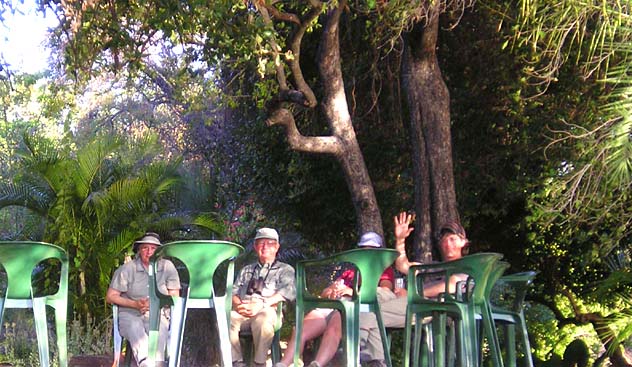
Day 25 (24 July): A full day on
the Okavango River by boat, cruising both downstream and upstream of camp.
We got to see the difficult papyrus bird (e.g., Chirping Cisticola,
Little Bittern); sandbars with African Skimmers; isolated clumps
of riverine thickets that served as day roosts for White-backed Night-Heron;
flooded backwaters with glimpses of Sitatunga and
African Pygmy-Geese;
and great experiences with otters.
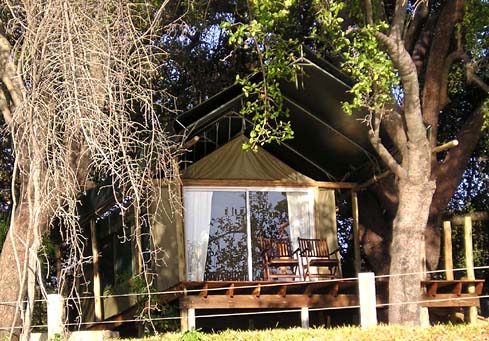 Xaro
Camp (pronounced "Karo Kamp") was lovely. We had glass-fronted chalets
(right) fronting the river. White-fronted Bee-eaters perch on the
hanging vines in front of our cabin (and in summer, swarms of Carmine Bee-eaters
will also be in, but they were entirely gone in winter). The only negatives
were how cold it got at night and the fact that one had to leave the chalet
to visit the restroom/shower bungalows. But meals were very good, and the
alcoholic selection excellent. Xaro
Camp (pronounced "Karo Kamp") was lovely. We had glass-fronted chalets
(right) fronting the river. White-fronted Bee-eaters perch on the
hanging vines in front of our cabin (and in summer, swarms of Carmine Bee-eaters
will also be in, but they were entirely gone in winter). The only negatives
were how cold it got at night and the fact that one had to leave the chalet
to visit the restroom/shower bungalows. But meals were very good, and the
alcoholic selection excellent.
The woods around camp were good for many new trip birds,
some of them lifers. We were taken to a Pel's Fishing-Owl roost
at mid-day, being very careful not to disturb them. At dusk the evening
before, Richard had called in an African Barred-Owlet for Ed and
me. Other woodland highlights included Western Banded Snake-Eagle
and Retz's Helmet-Shrike.
Day 26 (25 July): We had a long
way to go today, so we reluctantly left Xaro Camp after breakfast for Drotsky's
(picked up Arrow-marked Babbler, Terrestrial Brownbul, and Yellow-fronted
Tinkerbird there) and headed back north into Namibia. We stopped at Mahunga
Reserve again. No cranes today but an African Barred-Owlet was calling
mid-morning and Richard brought him in for Rita's lifer. There were fresh
Lion tracks (so were cautious when outside the vehicle) and more Roan Antelope.
We drove back through the Caprivi Strip (lunch in Rundu)
and into the main part of northern Namibia. As Roy's Camp was full, we
had booked the only alternative nearby as a convenient stopping point for
the night: Dornhugel's Game Farm. This proved to be a small family-run
farm in ranch land (not good for birds) but interesting because it was
now operated as a bed-and-breakfast by a German couple, and all the guests
were German tourists. We had interesting discussions about Europe, Namibia
(and its Germanic heritage), and American politics over an abundant dinner
table and while drinking 'sun-downers' at the outdoor fire pit. It was
not a shock to find that all the Europeans agreed with us that Bush is
a disastrous President. It was a shock to learn that even the folks living
on remote ranches in Namibia had watched and knew everything about the
TV show Desperate Housewives! |







 Day
24 (23 July): Our accommodations near Rundu at the entrance
to the Caprivi Strip was Nkwazi Camp, a small establishment right on the
banks of the Kavango River (which is called the Okavango River in Botswana).
We looked directly across into Angola. War-torn Angola is now open for
visitors again, but we ran into several folks who had been there recently
(including one who did U.N. refugee work), and learned the country is dysfunctional;
bribery is rampant and required to accomplish anything; and that land mines
present a major problem. Nonetheless it was interesting to look across
and, as it turned out, we saw one lifer — Coppery-tailed Coucal — in Angola
before it was seen elsewhere. I actually have an 'Angola list' for about
a dozen species, without ever stepping foot inside the country. There were
a few new birds around camp (Swamp Boubou, Hartlaub's Babbler)
but mostly there were German tourists camping. It is very popular for campers
and backpackers to go on bus tours of this part of Africa. This is a cheap
way to see Africa, and dozens had arrived the night before to put up little
pup tents everywhere throughout the bit of woods around the resort.
Day
24 (23 July): Our accommodations near Rundu at the entrance
to the Caprivi Strip was Nkwazi Camp, a small establishment right on the
banks of the Kavango River (which is called the Okavango River in Botswana).
We looked directly across into Angola. War-torn Angola is now open for
visitors again, but we ran into several folks who had been there recently
(including one who did U.N. refugee work), and learned the country is dysfunctional;
bribery is rampant and required to accomplish anything; and that land mines
present a major problem. Nonetheless it was interesting to look across
and, as it turned out, we saw one lifer — Coppery-tailed Coucal — in Angola
before it was seen elsewhere. I actually have an 'Angola list' for about
a dozen species, without ever stepping foot inside the country. There were
a few new birds around camp (Swamp Boubou, Hartlaub's Babbler)
but mostly there were German tourists camping. It is very popular for campers
and backpackers to go on bus tours of this part of Africa. This is a cheap
way to see Africa, and dozens had arrived the night before to put up little
pup tents everywhere throughout the bit of woods around the resort.

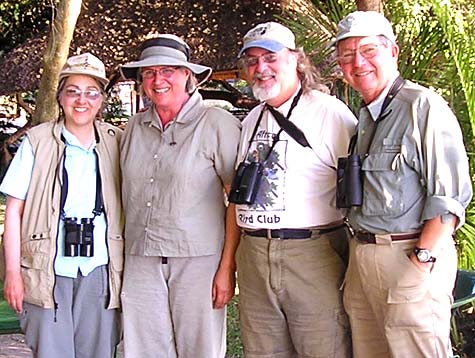

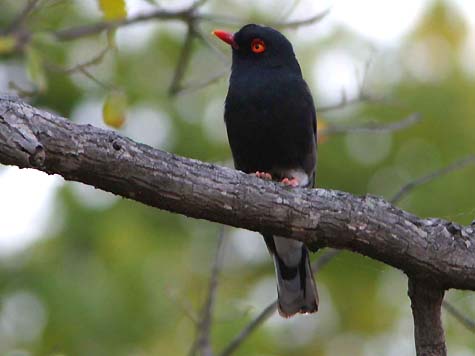

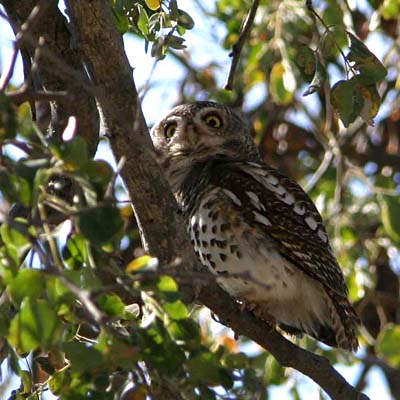
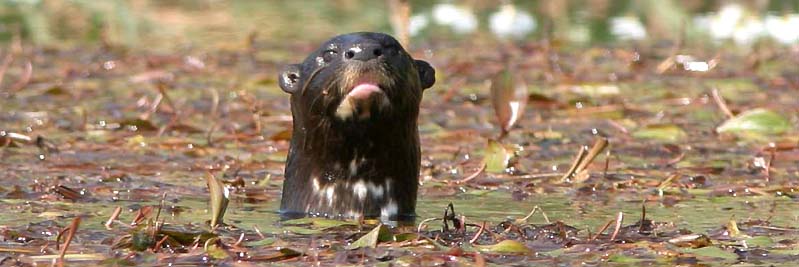
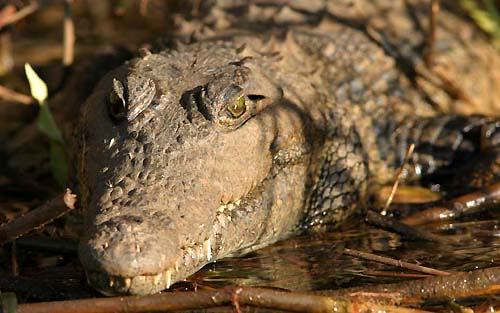 Scenes
from the Okavango River: a Spot-necked Otter gives us a careful
look (above) while a Nile Crocodile (right) eyed us warily from
the shallows. A Little Bittern (top left, below) flushes from the
Papyrus, which is the habitat for Chirping Cisticola (top right,
below). Other Okavango specialties include Hamerkop (bottom left,
below) and Comb Duck (bottom right, below).
Scenes
from the Okavango River: a Spot-necked Otter gives us a careful
look (above) while a Nile Crocodile (right) eyed us warily from
the shallows. A Little Bittern (top left, below) flushes from the
Papyrus, which is the habitat for Chirping Cisticola (top right,
below). Other Okavango specialties include Hamerkop (bottom left,
below) and Comb Duck (bottom right, below).


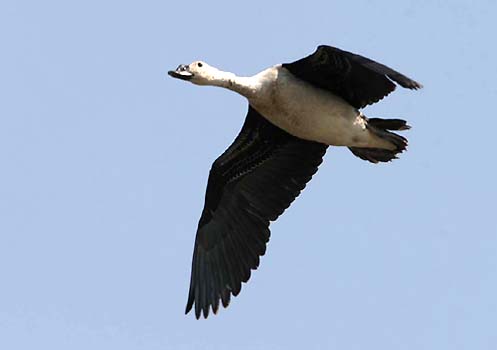

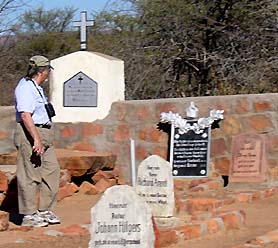 Day
27 (26 July): It's about a 4 hour drive to Waterberg Nat'l Park
from Dornhugel, blasting CDs in the Mercedes all the way as we watch for
the occasional raptor overhead. The Waterberg Plateau can be seen
from miles away in country recalling Utah, but the flat-topped plateaus
remind me of the tepuis of Venezuela. There is a 'hidden kingdom' atop
the plateau where White Rhinos have been reintroduced and lions roam, but
permits are needed to hike there and we won't have time. For us, we enjoy
the trails around the base of the cliffs; watch the Red-billed Francolins
stroll across the laws behind our rooms; and visit the German graveyard
filled with soldiers killed in the Herero uprising at the turn of the 20th
century (right).
Day
27 (26 July): It's about a 4 hour drive to Waterberg Nat'l Park
from Dornhugel, blasting CDs in the Mercedes all the way as we watch for
the occasional raptor overhead. The Waterberg Plateau can be seen
from miles away in country recalling Utah, but the flat-topped plateaus
remind me of the tepuis of Venezuela. There is a 'hidden kingdom' atop
the plateau where White Rhinos have been reintroduced and lions roam, but
permits are needed to hike there and we won't have time. For us, we enjoy
the trails around the base of the cliffs; watch the Red-billed Francolins
stroll across the laws behind our rooms; and visit the German graveyard
filled with soldiers killed in the Herero uprising at the turn of the 20th
century (right).
